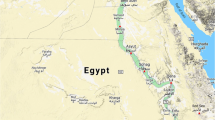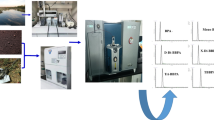Abstract
Bisphenol A (BPA) and nonylphenols (NP) are of major concern to public health due to their high potential for human exposure and to their demonstrated toxicity (endocrine disruptor effect). A limited number of studies have shown that BPA and NP are present in drinking water. The chlorinated derivatives that may be formed during the chlorination step in drinking water treatment plants (DWTP) exhibit a higher level of estrogenic activity than their parent compounds. The aim of this study was to investigate BPA, 353NP, and their chlorinated derivative concentrations using an accurate and reproducible method of quantification. This method was applied to both surface and treated water samples from eight French DWTPs producing from surface water. Solid-phase extraction followed by liquid chromatography–tandem mass spectrometry was developed in order to quantify target compounds from water samples. The limits of detection ranged from 0.3 to 2.3 ng/L for BPA and chlorinated BPA and from 1.4 to 63.0 ng/L for 353NP and chlorinated 353NP. BPA and 353NP were found in most analyzed water samples, at a level ranging from 2.0 to 29.7 ng/L and from 0 to 124.9 ng/L, respectively. In most of DWTPs a decrease of BPA and 353NP was observed between surface water and treated water (36.6 to 78.9 % and 2.2 to 100.0 % for BPA and 353NP, respectively). Neither chlorinated BPA nor chlorinated 353NP was detected. Even though BPA and 353NP have been largely removed in the DWTPs studied, they have not been completely eliminated, and drinking water may consequently remain a source of human exposure.




Similar content being viewed by others
References
Bhatt BD, Prasad JV, Kalpana G, Ali S (1992) Separation and characterization of isomers of p-nonylphenols by capillary GC/GC-MS/GC-MS/GC-FTIR techniques. J Chromatogr Sci 30:203–210
Chapin RE, Delaney J, Wang YF, Lanning L, Davis B, Collins B et al (1999) The effects of 4-nonylphenol in rats: a multigeneration reproduction study. Toxicol Sci 52:80–91
Deborde M, von Gunten U (2008) Reactions of chlorine with inorganic and organic compounds during water treatment—kinetics and mechanisms: a critical review. Water Res 42:13–51
Deborde M, Rabouan S, Gallard H, Legube B (2004) Aqueous chlorination kinetics of some endocrine disruptors. Environ Sci Technol 38:5577–5583
Deborde M, Rabouan S, Mazellier P, Duguet JP, Legube B (2008) Oxidation of bisphenol A by ozone in aqueous solution. Water Res 42:4299–4308
Dekant W, Volkel W (2008) Human exposure to bisphenol A by biomonitoring: methods, results and assessment of environmental exposures. Toxicol Appl Pharmacol 228:114–134
European Union (1997) European Workshop on the Impact of endocrine Disrupters on Human Health and the Environment
Fernandez MF, Arrebola JP, Taoufiki J, Navalon A, Ballesteros O, Pulgar R et al (2007) Bisphenol-A and chlorinated derivatives in adipose tissue of women. Reprod Toxicol 24:259–264
Fukazawa H, Watanabe M, Shiraishi F, Shiraishi H, Shiozawa T, Matsushita H et al (2002) Formation of chlorinated derivatives of bisphenol A in waste paper recycling plants and their estrogenic activities. J Health Sci 48:242–249
Gallard H, Leclercq A, Croue JP (2004) Chlorination of bisphenol A: kinetics and by-products formation. Chemosphere 56:465–473
Gallart-Ayala H, Moyano E, Galceran MT (2010) On-line solid phase extraction fast liquid chromatography-tandem mass spectrometry for the analysis of bisphenol A and its chlorinated derivatives in water samples. J Chromatogr A 1217:3511–3518
Guenther K, Kleist E, Thiele B (2006) Estrogen-active nonylphenols from an isomer-specific viewpoint: a systematic numbering system and future trends. Anal Bioanal Chem 384:542–546
Hu JY, Xie GH, Aizawa T (2002) Products of aqueous chlorination of 4-nonylphenol and their estrogenic activity. Environ Toxicol Chem 21:2034–2039
Kang JH, Kondo F, Katayama Y (2006) Human exposure to bisphenol A. Toxicology 226:79–89
Katase T, Okuda K, Kim YS, Eun H, Takada H, Uchiyama T et al (2008) Estrogen equivalent concentration of 13 branched para-nonylphenols in three technical mixtures by isomer-specific determination using their synthetic standards in SIM mode with GC-MS and two new diasteromeric isomers. Chemosphere 70:1961–1972
Kim YS, Katase T, Horii Y, Yamashita N, Makino M, Uchiyama T et al (2005) Estrogen equivalent concentration of individual isomer-specific 4-nonylphenol in Ariake sea water, Japan. Mar Pollut Bull 51:850–856
Lagana A, Bacaloni A, De Leva I, Faberi A, Fago G, Marino A (2004) Analytical methodologies for determining the occurrence of endocrine disrupting chemicals in sewage treatment plants and natural waters. Anal Chim Acta 501:79–88
Li X, Ying GG, Su HC, Yang XB, Wang L (2010) Simultaneous determination and assessment of 4-nonylphenol, bisphenol A and triclosan in tap water, bottled water and baby bottles. Environ Int 36:557–562
Liu R, Zhou JL, Wilding A (2004) Simultaneous determination of endocrine disrupting phenolic compounds and steroids in water by solid-phase extraction-gas chromatography–mass spectrometry. J Chromatogr A 1022:179–189
Loos R, Locoro G, Contini S (2010) Occurrence of polar organic contaminants in the dissolved water phase of the Danube River and its major tributaries using SPE-LC-MS(2) analysis. Water Res 44:2325–2335
Loyo-Rosales JE, Rosales-Rivera GC, Lynch AM, Rice CP, Torrents A (2004) Migration of nonylphenol from plastic containers to water and a milk surrogate. J Agric Food Chem 52:2016–2020
Nakada N, Shinohara H, Murata A, Kiri K, Managaki S, Sato N et al (2007) Removal of selected pharmaceuticals and personal care products (PPCPs) and endocrine-disrupting chemicals (EDCs) during sand filtration and ozonation at a municipal sewage treatment plant. Water Res 41:4373–4382
NTP (2008) NTP-CERHR Monograph on the Potential Human Reproductive and Developmental Effects of Bisphenol A. NIH publication n°08-5994 National Toxicology Program/National Institute of Environmental Health Sciences
Petrovic M, Diaz A, Ventura F, Barcelo D (2001) Simultaneous determination of halogenated derivatives of alkylphenol ethoxylates and their metabolites in sludges, river sediments, and surface, drinking, and wastewaters by liquid chromatography-mass spectrometry. Anal Chem 73:5886–5895
Petrovic M, Diaz A, Ventura F, Barcelo D (2003) Occurrence and removal of estrogenic short-chain ethoxy nonylphenolic compounds and their halogenated derivatives during drinking water production. Environ Sci Technol 37:4442–4448
Polo M, Llompart M, Garcia-Jares C, Gomez-Noya G, Bollain MH, Cela R (2006) Development of a solid-phase microextraction method for the analysis of phenolic flame retardants in water samples. J Chromatogr A 1124:11–21
Preuss TG, Gehrhardt J, Schirmer K, Coors A, Rubach M, Russ A et al (2006) Nonylphenol isomers differ in estrogenic activity. Environ Sci Technol 40:5147–5153
Rodriguez-Mozaz S, de Alda MJL, Barcelo D (2004) Monitoring of estrogens, pesticides and bisphenol A in natural waters and drinking water treatment plants by solid-phase extraction–liquid chromatography–mass spectrometry. J Chromatogr A 1045:85–92
Saito H, Uchiyama T, Makino M, Katase T, Fujimoto Y, Hashizume D (2007) Optical resolution and absolute configuration of branched 4-nonylphenol isomers and their estrogenic activities. J Health Sci 53:177–184
Soares A, Guieysse B, Jefferson B, Cartmell E, Lester JN (2008) Nonylphenol in the environment: a critical review on occurrence, fate, toxicity and treatment in wastewaters. Environ Int 34:1033–1049
Stackelberg PE, Gibs J, Furlong ET, Meyer MT, Zaugg SD, Lippincott RL (2007) Efficiency of conventional drinking-water-treatment processes in removal of pharmaceuticals and other organic compounds. Sci Total Environ 377:255–272
Stavrakakis C, Colin R, Hequet V, Faur C, Le Cloirec P (2008) Analysis of endocrine disrupting compounds in wastewater and drinking water treatment plants at the nanogram per litre level. Environ Technol 29:279–286
Vandenberg LN, Hauser R, Marcus M, Olea N, Welshons WV (2007) Human exposure to bisphenol A (BPA). Reprod Toxicol 24:139–177
Vandenberg LN, Chahoud I, Heindel JJ, Padmanabhan V, Paumgartten FJR, Schoenfelder G (2010) Urinary, circulating, and tissue biomonitoring studies indicate widespread exposure to bisphenol A. Environ Health Perspect 118:1055–1070
Voutsa D, Hartmann P, Schaffner C, Giger W (2006) Benzotriazoles, alkylphenols and bisphenol A in municipal wastewaters and in the Glatt River, Switzerland. Environ Sci Pollut Res Int 13:333–341
Wheeler TF, Heim JR, LaTorre MR, Janes AB (1997) Mass spectral characterization of p-nonylphenol isomers using high-resolution capillary GC-MS. J Chromatogr Sci 35:19–30
Yamamoto T, Yasuhara A (2002) Chlorination of bisphenol A in aqueous media: formation of chlorinated bisphenol A congeners and degradation to chlorinated phenolic compounds. Chemosphere 46:1215–1223
Acknowledgments
Thanks to Pascale Pierre-Eugène for her help as technical assistant. Thanks to Ianesco laboratory (Poitiers, France) for their LC-MS/MS analysis contribution. Thanks as well to Afsset (EST-2007-70/LEGUBE) for their financial support. And thanks to all the DWTP operators and state organs managing delivery of drinking water in the Poitou-Charentes region for their kind assistance as we carried out this study. We would also like to thank Jeffrey Arsham for a very helpful discussion.
Author information
Authors and Affiliations
Corresponding author
Additional information
Responsible editor: Leif Kronberg
Rights and permissions
About this article
Cite this article
Dupuis, A., Migeot, V., Cariot, A. et al. Quantification of bisphenol A, 353-nonylphenol and their chlorinated derivatives in drinking water treatment plants. Environ Sci Pollut Res 19, 4193–4205 (2012). https://doi.org/10.1007/s11356-012-0972-3
Received:
Accepted:
Published:
Issue Date:
DOI: https://doi.org/10.1007/s11356-012-0972-3




